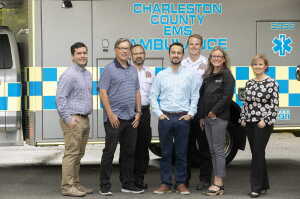by
John R. Fischer, Senior Reporter | November 20, 2023

MUSC researchers equipped an ambulance with a portable MR scanner for stroke care. (Photo courtesy of MUSC)
In a trial run, researchers at the Medical University of South Carolina (MUSC) were able to produce quality scans in a moving ambulance with a low-field, portable MR scanner, giving them an idea of how the technology could change out-of-hospital stroke care.
The clinicians equipped one of the Charleston County Emergency Medical Services’ (EMS) ambulances with a Hyperfine Swoop Portable MR system. The solution, which was
rolled out in 2020, is designed to provide neuroimaging at patient bedsides and has a 0.64 Tesla magnet, giving it a significantly lower magnetic field than that of a standard scanner, and requiring no shielding.
Charleston County EMS personnel drove the ambulance slowly around a parking lot, while the researchers scanned a healthy volunteer inside. They obtained and successfully transmitted scans to hospital radiologists for review.



Ad Statistics
Times Displayed: 46604
Times Visited: 1410 MIT labs, experts in Multi-Vendor component level repair of: MRI Coils, RF amplifiers, Gradient Amplifiers Contrast Media Injectors. System repairs, sub-assembly repairs, component level repairs, refurbish/calibrate. info@mitlabsusa.com/+1 (305) 470-8013
While traditional mobile stroke care units use CT, MR spares patients from radiation exposure and also “picks up certain abnormalities not readily apparent with CT scan, including better accuracy in assessing stroke,” Dr. Dustin LeBlanc, director of prehospital medicine and associate chief medical officer for emergency management at MUSC, told HCB News.
While CT scans are faster to perform than MR imaging, it can be several hours before they can identify any blockages in blood flow that are signs of a stroke. Because it's more sensitive, an MR scanner can pick up on tiny abnormalities and brain damage within an hour.
Swoop’s lower magnetic field is what made it the researchers’ choice for their study because it reduces concerns about nearby metal and allows for personnel to use other medical and electronic equipment in its presence. The size of Swoop also makes it 20 times cheaper, 10 times lighter, and able to run on 35 times less power than fixed MR scanners, according to Hyperfine.
LeBlanc and his colleagues say that using MR in place of CT would accelerate stroke responses and open up the potential to better determine and divert patients to the best healthcare facility based on the type of stroke they incur. For example, a patient who only needs the clot-busting drug tissue plasminogen activator (tPA) could be sent to a local hospital, while one in need of interventional neuroradiology would be better off at a more advanced hospital.
But before this ambulance-based technology can be used in real-world, clinical scenarios, more research and technical refinements are required, including testing the quality of scanning at full speed.
The researchers plan to do this in further clinical trials, says LeBlanc, and are working with the university’s Clemson School of Engineering to optimize the ergonomic fit of the MR scanner in the ambulance.
“The real benefit may come in rural areas where patients may be hours or further away from an MR,” said Jillian Harvey, a professor in the College of Health Professions, in a statement.
The findings were published in the October issue of the
Journal of Stroke and Cerebrovascular Diseases.

